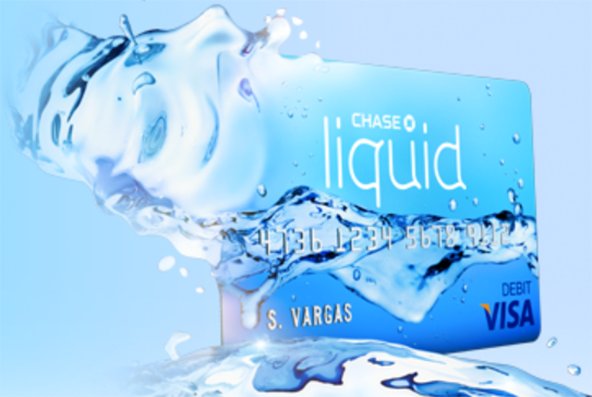Prepaid Cards Keep Getting Better

Chase is the latest big bank to enter the prepaid card market in a serious way. Its new entry into the increasingly crowded field — called Liquid — is a worthy competitor to Americans Express’ prepaid card, which until now was the undisputed leader. AmEx’s product is still the best option for everyone with a poor FICO score whose primary goal is to get back into the credit system, because it offers a path to a charge card. Everyone else, however, now has a choice between two very good prepaid cards.
The Liquid card is very much like a Chase debit card, with the only difference, as far as I can tell, being that it is not linked to a checking account and so its users have no access to checks. Other than that, the two card types are indistinguishable. If there is still someone left out there who is asking “Why would a bank like Chase bother to be issuing debit-card-like prepaid cards?”, the answer, of course, is that the Durbin Amendment slashed the revenues big issuers are getting from debit transactions by 45 percent, while leaving credit and prepaid interchange fees untouched. The vastly improved quality of prepaid cards is one of the very few beneficial side effects to come out of this poorly designed legislation. Let’s take a closer look at the Liquid.
Chase Liquid
At present, Chase’s new prepaid card is in a test mode and can only be applied for in person at around 200 of the bank’s branches. The applicants are required to bring a photo ID (i.e. a driver’s license or a passport) and their Social Security Card. These documents are needed for identification purposes, not for establishing the applicant’s eligibility for the card. After all, this is a prepaid card, so the issuer’s risk exposure is very limited. Once the application process is completed, the consumer gets a temporary card and, a couple of weeks later, a personalized permanent one is received by mail.
Liquid can be used at no charge at Chase’s ATM network and is accepted anywhere Visa cards are accepted. Refills are free at Chase branches or ATMs, as well as online or by phone. Users can set up direct deposits for their paychecks or government benefits. The card comes with a $4.95 monthly fee and there are virtually no other fees.
Liquid vs. AmEx Prepaid
The two cards are very similar. The most significant differences between them are listed in the table below:
| ?á |
American Express Prepaid |
Chase Liquid |
|
Monthly fee |
$0 |
$4.95 |
|
ATM withdrawal |
One free monthly withdrawal and $2.00 per withdrawal thereafter* |
$0 at Chase ATMs and $2 at non-Chase ATMs* |
|
Maximum balance |
$2,500.00 |
n/a |
|
Path to a charge / credit card |
Yes |
No |
*The ATM operator may charge a separate fee.
The main disadvantage of AmEx’s card is that its issuer doesn’t have its own ATM network, whereas Chase has more than 17,500 ATMs across the country. AmEx may not charge you for your first monthly withdrawal, but the ATM owner will, so even two withdrawals per month will cost you more than the monthly fee paid by Liquid users.
Moreover, ATMs are not used only for withdrawals. A Liquid user can go to a Chase ATM and deposit her paycheck into her prepaid account at no charge. An AmEx user doesn’t have this option. Of course, both issuers support direct deposits, but there is a difference here, too. Both companies allow paychecks to be direct-deposited, but Chase also supports government benefits while AmEx doesn’t.
On the other hand, AmEx’s big advantage is that its prepaid card offers a path to a charge card, which is a form of credit card whose balance must be paid in full at the end of each month. Now, people have different views on credit cards; some like them and others don’t. However, whatever you may think of them, credit cards are the only type of payment card that has any effect on your credit history. And you do have to care about your credit history.
The Takeaway
So a direct comparison between these two prepaid cards doesn’t produce an undisputed champion. Each of them has its advantages and disadvantages over the other. And yet, I still find myself leaning toward AmEx’s card, because of its prepaid-to-charge-card program. Why do I like it so much? Well, for example, you can get one for your college student, explain how and where she can use it and what ATM fees are charged. Then, when and if she shows a usage pattern that AmEx’s system likes, she will be offered a charge card and start building her credit history. Of course, there are some under-21 restrictions to be complied with, but you get the point. Chances are that the student would now be much better prepared to handle a charge card than she would have been if her first card was a credit one.
Image credit: JP Morgan Chase.



I don’t see the point in this card. There is a ton of free and easy to get checking accounts available through credit unions and small banks, so why open a prepaid card? The only people who may want to use it are people who will not be taken as customers by any bank.
Jimmy, that’s exactly the point. Prepaid cards are for people with no access to bank accounts. And the fact is that compared to most other prepaid cards the Chase card is real good, almost like a debit card.
I don’t get that. I have totally free checking account with my credit union and a debit card to come with it. I pay no fees at all. I just can’t believe that it’s that difficult for people to get a free checking account so they have to rely on prepaid cards.
Well, you obviously have no idea what it’s like to have your credit history destroyed for no fault of your own and get turned down by every bank you ask for a credit card or a debit card. Prepaid cards are not for people like you.
It seems to me that Chase counts on the poor being stupid and pay for their prepaid card when they can go to the credit union down the street and open a checking account for free. I hope they’ll be disappointed but I’m sure some people will unfortunately go for it.
The “unbanked” actually have quite a few real good banking options and I think it’s about time they started spending more time looking for ways to make money. Once they start doing that, banks will offer them all kinds of free services.
Prepaid has a distinct advantage over debit and credit and it is that users just cannot go over their limit, so the risk of getting in trouble is low. So there is a market beyond the unbanked for this product.
The only reason that we have all the big banks issuing prepaid cards now is that it is to their advantage to push people away from debit. That’s all. Prepaid is not better than debit, but it’s more profitable for Chase. AmEx is somewhat different story, because they don’t issue debit cards, but I guess they have to stake out their territory in the new market as well.
I’ve been reading a lot of pushback against this card elsewhere, but I think this is a good card, whatever reasons Chase may have for issuing it now. It is every bit as good as most debit cards and everyone can get it.
I’m sticking to my credit union debit card. I’ve had it for 15 years, pay no fees and am very happy with it. Chase can keep its prepaid card and all other services it offers, I don’t want them.
It makes no sense to use a prepaid card if you can open up a bank account and get a debit card along with a check book. Prepaid cards can never get better than debit.
Chris P, Eric, Peter and any others who agree with them: You have missed the point of Prepaid entirely. YOU are able to get a free checking account because you have managed to avoid financial meltdown. Not everyone is as fortunate. Some people are flat out horrible with money (like myself), and must learn through trial and error. I personally blame Bank of America for offering me a credit card when I was 19 years old (almost ten years ago), that had a $2500 limit. Naturally, I maxed it out, attempted to repay it, and was quickly overburdened by other unforeseeable events (among them, an ER visit for a head injury and a second ER visit for an injury to my hand that required six stitches).
My credit has been destroyed and at one point, I was playing cat and mouse with the bank’s overdraft policy by intentionally overdrafting the limit, eating the $34 overdraft fee, then paying it off in total when my paycheck’s direct deposit was made.
Today, I’ve managed to untangle most of those finances and my spending habits are borderline militaristic, but my credit is still ruined and at this moment, I can choose to spend $500 to make repairs on my aging vehicle, or $500 to pay off the defaulted checking account that went into overdraft over two years ago. Until that balance is paid, I do not qualify for a checking account at a bank or credit union.
But guess what? I still have bills. And since i don’t have a bank account, I don’t have the luxury of automatic drafts or writing checks.
But for five dollars a month, I can pay these bills without spending an additional $4 in gas driving to a post office, which charges another $1.50 for ONE money order. The monthly fee justifies itself after being able to pay a single bill from home or work.
I hope this message reaches you guys as a gesture of goodwill and perspective, because now you know that for me, and probably many other people in similar situations, this card makes perfect sense.
You can’t get in trouble with prepaid, unlike with credit cards, so for many people that is the way to go.
Yes, Chase Liquid is a very good prepaid card and it’s a great option for consumers with no access to credit cards. Come to think of it, it’s also a great option for those of us who can’t control their spending — you can’t spend more than what you’ve deposited into your prepaid account.